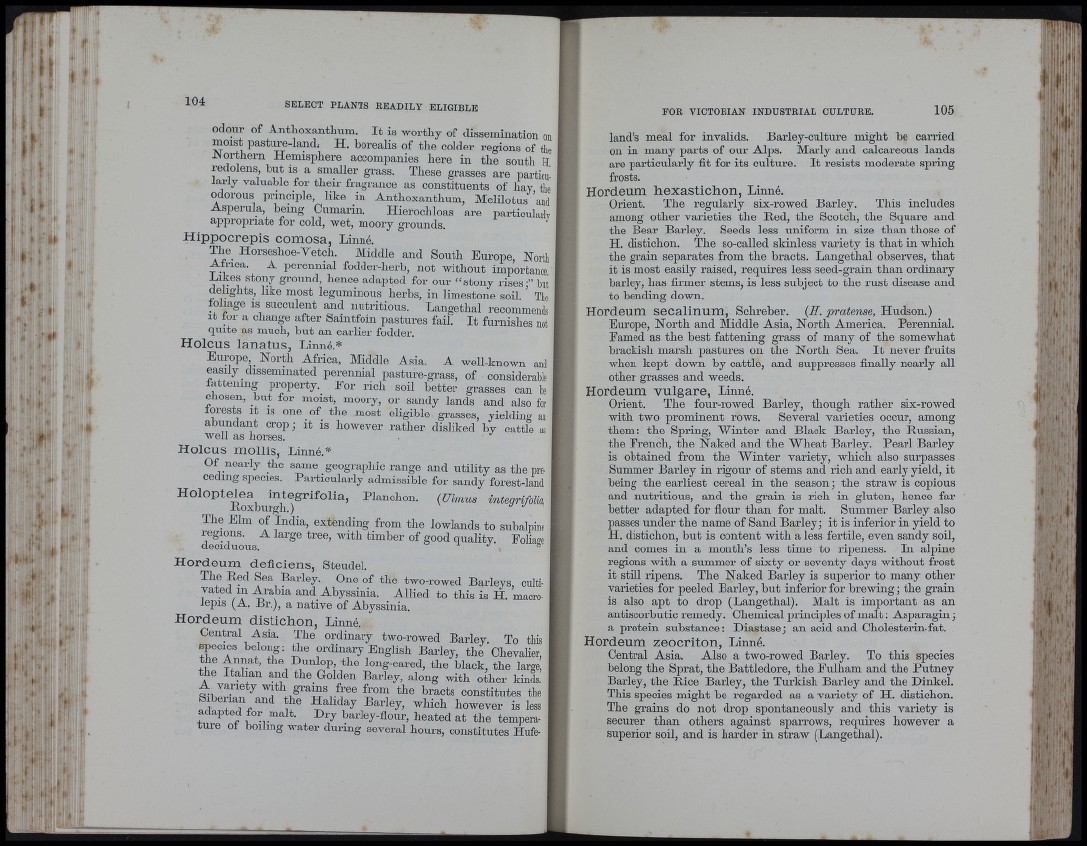
f
, !f*
«ilÎi
' r
■ tH
#
•H*
4 iilH
t'» I '
odour of Antlioxanthum. I t is worthy of dissemination on
moist pastnre-land.- H. borealis of tbe colder regions of the
Northern Hemisphere accompanies here in the south H
redolens, but is a smaller grass. These grasses are particularly
valuable for their fragrance as constituents of hay the
odorous principle, like in Anthoxanthum, Melilotus and
Asperiila, being Ciimarin. Hierochloas are particularly
approjiriate for cold, wet, moory grounds.
Hippocrepis comosa, Linné.
The_ Horseshoe-Vetch. Middle and South Europe, North
Airica. A perennial fodder-herb, not without importance
-Likes stony ground, lience adapted for our “ stony rises-” but
delights, like most leguminous herbs, in limestone soil ’ The
foliage IS succulent and nutritious. Langethal recommends
It tor a change after Saintfoin pastures fail. I t furnishes not
quite as much, but an earlier fodder.
Holcus lanatus, Linné.*
Europe North Africa, Middle Asia. A well-known and
easily disseminated perennial pasture-grass, of considerable
iattenmg property.^ Eor rich soil better grasses can be
chosen, but for moist, moory, or sandy lands and also for
forests It IS one _ of the most eligible grasses, yielding an
abundant crop ; it is however rather disliked by cattle as
■vvell as horses.
Holcus mollis, Linné.*
Of nearly the same geographic range and utility as the preceding
species. Particularly admissible for sandy forest-land,
H o lo p te f f ia b ^ in te g r ifo lia , Planchon. (Ulmus integrifoUa,
Tbe Elm of India, extending from the lowlands to subalpine
S id u o n s quality. Foliage
Hordeum deficiens, Steudel.
The Red Sea Barley. One of the two-rowed Barleys, cultivated
in Arabia and_ Abyssinia. Allied to this is H. macro-
lepis (A. Br.), a native of Abyssinia.
Hordeum distichon, Linné.
Central Asia. The ordinary two-rowed Barley. To this
species belong : the ordinary English Barley, the Chevalier,
the Annat, the Dunlop, the long-eared, the black, the large,
the Italian and the Golden Barley, along with other kinds,
A variety with grains free from the bracts constitutes the
Siberian and the Haliday Barley, which however is less
adapted for malt. Dry barley-ilour, heated at the temperature
of boiling water durmg several hours, constitutes Hufeland’s
meal for invalids. Barley-culture might be carried
on in many parts of our Alps. Marly and calcareous lands
are particularly fit for its culture. I t resists moderate spring
frosts.
Hordeum Bexastichon, Linné.
Orient. The regularly six-rowed Barley. This includes
among other varieties the Red, the Scotch, the Square and
the Bear Barley. Seeds less uniform in size than those of
H. distichon. The so-called skinless variety is th a t in which
the grain separates from the bracts. Langethal observes, that
it is most easily raised, requires less seed-grain than ordinary
barley, has firmer stems, is less subject to the rust disease and
to bending do wn.
Hordeum secalinum, Schreher. (H. pratense, Hudson.)
Europe, North and Middle Asia, North Ameiica. Perennial.
Famed as the best fattening grass of many of the somewhat
brackish marsh pastures on the North Sea. I t never fruits
when kept down by cattle, and suppresses finally nearly all
other grasses and weeds.
Hordeum vulgare, Linné.
Orient. The four-rowed Barley, though rather six-rowed
with two prominent rows. Several varieties occur, among
them: the Spring, Winter and Black Barley, the Russian,
the French, the Naked and the Wheat Barley. Pearl Barley
is obtained from the Winter variety, which also surpasses
Summer Barley in rigour of stems and rich and early yield, it
being the earliest cereal in the season; the straw is copious
and nutritious, and the grain is rich in gluten, hence far
better adapted for fionr than for malt. Summer Barley also
passes under the name of Sand Barley; it is inferior in yield to
H. distichon, but is content with a less fertile, even sandy soil,
and comes in a month’s less time to ripeness. In alpine
regions with a summer of sixty or seventy days without frost
it still ripens. The Naked Barley is superior to many other
varieties for peeled Barley, but inferior for brewing ; tbe grain
is also apt to drop (Langethal). Malt is important as an
antiscorbutic remedy. Chemical principles of malt : Asparagin ;
a protein substance: Diastase; an acid and Cbolesterin-fat.
Hordeum zeocriton, Linné.
Central Asia. Also a two-rowed Barley. To this species
belong the Sprat, the Battledore, the Fulham and the Putney
Barley, the Rice Barley, the Turkish Barley and the Dinkel.
This species might be regarded as a variety of H. distichon.
The grains do not drop spontaneously and this variety is
securer than others against sparrows, requires however a
superior soil, and is harder in straw (Langethal).
I ■
Î*'